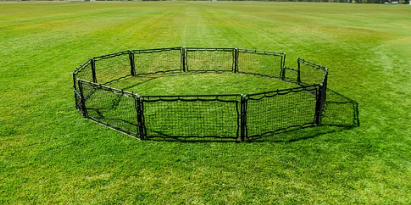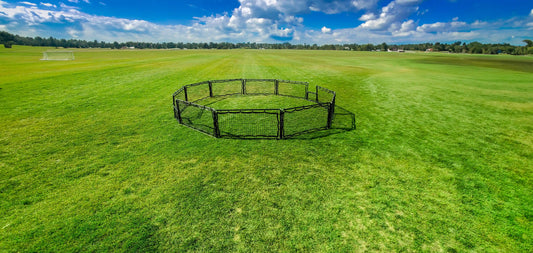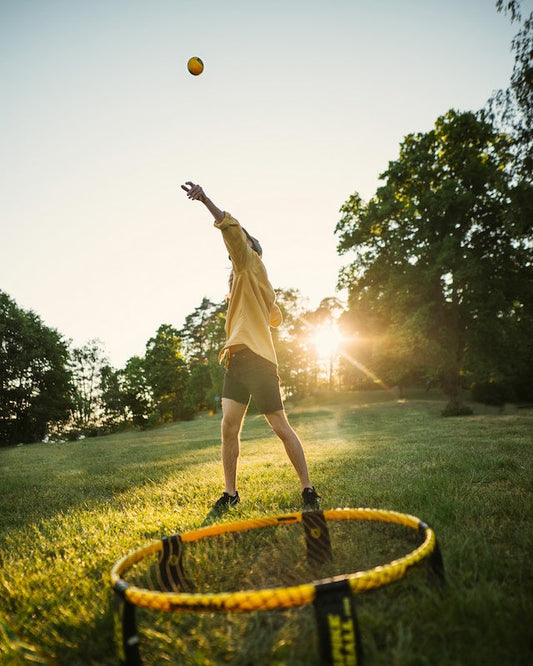Four Square is one of the most common playground games for elementary school and middle school. It's competitive, without the hurt of losing. Every player in four square has a chance to win, making it exciting for each child, even when they're stepping onto the court for the first time.
However, as the school year continues, some players could get bored of the same four square rules every day. To help keep recess fresh, here are 15 new four square games.
How to Play 4 Square
Four Square is a simple game to play. Most schools will create their own rules and variations of the game. Here are the basic, most standard rules for elementary and middle school four square:
- The player in the queen/king square serves the rubber playground ball by dropping it into his/her square and hitting it into another player's square.
- Players can hit and return the ball by hitting it with any part of their arm or hand. Depending on the variation of rules, the ball cannot hit in that player's square more than once, or the player is out.
- If the player is out, they either go to the back of the line of players waiting to enter the game or go to the lowest square. All other players move up to take that player's place.
- The goal is to make it to the Queen/King square and stay there for as long as possible.
Once the players establish basic rules, they can start adding new rules to the game. New rules and variations help keep the game exciting and encourage new players to join. Keep reading to learn 15 new four square variations.
1. 9 Square
The first variation is a game called 9 Square. Instead of having four players, it includes nine players all at the same time. 9 Square is a fun variation between it entirely twists the game of Four Square to create something new.
To play, you will need a 9 Square court, which is a three by three raised court. Players stand inside their square and set the ball up and over into another player's square as if setting a volleyball. Volleyball players will immediately connect to this version of Four Square because it helps them practice setting the ball and hone the technique.
Aside from hitting the ball up, 9 Square's rules are mostly the same as the rules of Four Square. Players can also create variations while playing 9 Square and add their own twists to the game. For example, the players could choose to have the Queen play with one hand behind their back to create a faster turnover.

2. Jedi Ball
Jedi Ball creates instant, hilarious fun while using the same rules as a traditional Four Square game--with one major twist. Before hitting the ball, players have to close their eyes. If they hit the ball with their eyes open, they're out. Players can have their eyes open before and after hitting the ball.
Jedi Ball makes Four Square more difficult and perfect for older players looking for a hilarious, more difficult version of the game. It's more intense, frustrating, and has a faster turnover rate than the original Four Square.
To summarize, Jedi Ball has one special rule:
- Use the force to hit the playground ball with your eyes closed.
Star Wars fans will also love this game and have fun repeating phrases from the Star Wars franchise, such as, "[Insert player's name], I am your father." To which the player responds with a long, drawn-out, "Nooooooo!" You might also hear players saying, "You were the chosen one!" when a player gets out too early.
In short, Jedi Ball is a fun twist for older kids and Star Wars fans.

3. Zombie Ball
After you show the Star Wars fans how to incorporate their fandom, it's time to show zombie fans a fun way to include their favorite monster. This is a great game during October as well since it lets the kids act like monsters during the game.
The rules of Zombie Ball are the same as Four Square, with one change, the kids aren't allowed to bend their arms. Everyone has to play the game with their arms held perfectly straight, no matter what. If someone bends their arms, their arms "fall off," and they must try to last the round without any arms (a major disadvantage). For obvious reasons, the kids have the motivation to keep their arms straight like zombies.
Zombie Ball is hilarious to watch, especially as the kids are encouraged to make zombie noises when they hit the ball with their straight arms. Although this game is perfect for any time of the year, you'll see its popularity spike during Halloween.

4. Queen Flamingo
Queen Flamingo adds a challenge for the person in the Queen or King spot, helping the game to have a faster turnover rate and giving more players a place in the spotlight. Additionally, Queen Flamingo is an easy variation to learn since the Queen or King is the only person who has to play with the disadvantage.
The person playing in the Queen or King's square has to balance on one leg, hopping around to hit the rubber ball back and forth with the other players. This adds a considerable challenge to the Queen, making it harder for them to hold their place in power. However, it makes it more fun for the other players, especially when playing with someone who tends to hold the Queen's square for multiple rounds.
Queen Flamingo is a great challenge for experienced players and adds a fun twist to the classic Four Square game.

5. Kangaroo Ball
Kangaroo Ball encourages the kids to jump constantly and get more out energy during recess. The special rule in Kangaroo Ball is:
- Players must jump while hitting the ball.
As a player hits the ball into an opponent's square, the player must have both feet off the ground. When the receiving player gets the ball, they also have to jump as they hit the ball to another opponent.

6. Spikeball
Take the kids away from the Four Square court and introduce them to Spikeball. Spikeball has a similar premise while also offering an entirely new game. Spike Ball might not be the best game for young kids and is better suited for older middle grade and high school (even college). If you're working with a young group of kids, the precision needed in Spikeball might be too difficult.
Spikeball comes with a small netted trampoline that players hit the ball on. When the ball hits the trampoline, it bounces up. This game requires technique, aim, and precision, as well as teamwork and competitiveness.
There are two teams, each with two players. The players can hit the ball between team members up to three times. As soon as the ball touches the trampoline, the turn changes to the opposing team. If one of the team fails to complete their turn, they lose the point.
Introducing an older group of kids to Spikeball is a great way to encourage a healthy life.

7. Robot 4 Square
Robot Four Square is another fun version of Four Square with the standard rules and one special rule. The special rule is that players are robots. They have to move like robots, talk like robots, and hit the ball like robots. If someone breaks character, they're out of the game.
Robot Four Square is a hilariously fun role-playing game paired with the competition of Four Square. Because it requires the kids to use their imagination, this is a great game for young kids in elementary school.
Before starting the game, the kids can declare what type of robot they are and their backstory, adding more to the game's intricacy. The main purpose of Robot Four Square is to get the kids thinking creatively and using their imagination.

8. Inside the Lines
Kids can play Inside the Lines like regular Four Square. There are few special rules, and it is easy to learn because there's only one additional rule: the ball can't touch the lines. If a ball hits any of the Four Square court lines, the person who hit the ball is out.
In standard Four Square, the lines count as within the bounds of the court. However, in Inside the Lines, the lines are no-mans-land, meaning that if the ball touches one of the lines (any of the lines), the player is out.
This can be a fun version to play with a court drawn in chalk with atypical lines. Have the kids draw wavy boxes so that the players have to think hard about where they're aiming their shot. They have to be careful, or else they might hit the ball either out of bounds or hit one of the lines.

9. No Hands
No Hands is a great game for both young kids and older students. Everyone will have fun with this version of Four Square. The special rule of this game is simple:
- Players can't use their hands.
Players can use anything but their hands. They can hit the ball with their feet, elbows, heads, or knees, but can't use their hands. This creates an interesting game where players are simply struggling to learn foot-eye coordination. The students could choose to hold their hands behind their backs to prevent the temptation to touch the ball.
This game variation also requires that the players change the standard Four Square rules since the players' accuracy decreases. Add a rule that allows balls to bounce twice in any player's square before hitting it out.

10. Tornado Ball
Tornado Ball has the same premise as Kangaroo Ball, but with another special rule. In Kangaroo Ball, the players must jump as they hit the ball. With Tornado Ball, players must jump, hit the ball, and rotate 360 degrees in the air.
Tornado Ball lets the kids pretend that hitting the ball turns them into mini-tornadoes. Encourage the kids to make "whooshing" noises as they jump and spin, adding to the imagination behind the game. The purpose of this version is to get the kids to expend extra energy through the game, making them extra tired before they walk back into the classroom.
It encourages the students to use their imagination, which could lead the kids to create additional versions of the game. Fans of Avatar the Last Airbender, a popular Japanese-style kids' cartoon, could add elemental twists to the game. This version would require all of the kids to claim an element and pretend to hit the ball with that element.
Tornado Ball opens the court to new games and helps the kids to use their imagination.

11. Queen's Court
There are two variations of this game: Queen's Court and Jester's Court. The first, Queen's Court, lets the person in Queen or King square pick the rules for that round. They can choose to have all the players hop on one foot (including themselves). All rules apply to each square, and the Queen's rule can't single out one player to be exempt from any rule he or she chooses to propose.
The second variation is Jester's Court. In this variation, the person in the last square picks the rules, hopeful giving them an advantage. The Jester is exempt from the chosen rule, giving them a chance to move up. However, as soon as they move up, a new Jester takes his or her place. This means that the Jester can only choose a rule for one round before someone else takes power.
This unique game lets the different players have power through the game, making it more exciting for all players involved.

12. Category Ball
Category Ball is a fun way to get the kids thinking while exercising. Instead of just playing Four Square, this version makes the kids think hard about what they're going to say.
Before starting, the server picks a category. Some category ideas include:
- Ice cream flavors
- Names of cartoon characters
- Colors
- Famous people
As long as there are more than ten options in a category, it's fair game. Once the server picks a category, they serve the ball. As the next player hits the ball, they must say something in that category. The game continues until someone messes with the ball or can't answer the category in time.
This fun variation keeps everyone on their toes, ensuring that the entire group is thinking and brainstorming together.

13. Name Game
Name Game is ideal for the first day of school when everyone is still learning their classmates' names. Name Game is fun while also acting as an icebreaker and forcing the class to get to know each other's names.
To play, the Queen serves the ball to one of the other players. Before they hit the ball, they must say the name of their person they are serving to. The ball must go to that person, or the server is out. When the person correctly receives the ball, they have to say a name before hitting it. Again, the ball has to go to the person with the name that was called. When someone calls out a name, they have to call out the name correctly and then aim for that player's square.
Name Game helps the players learn their classmates' names by incorporating a fun game into a class name icebreaker. Hopefully, by the end of this game, everyone will have all the class memorized names.

14. Story Telling
Story Telling creates random, hilarious stories from the group's collective mind. To play, the server serves the ball while saying one to two words such as, "Once upon…" The next person hits the ball and says one to two words, "...a time…" The third person hits the ball and continues, "...a boy…"
The story goes around and around, echo person adding one to two words as they hit the ball. If someone misses the ball or forgets to add to the story, the story pauses, and that person goes to the last square while the other players move up. Once everyone is back in place, the server begins again, starting where they left off.
The mind of a child is impressively creative. After a few minutes, the kids will create intricate stories about dragons and monsters, unicorns and mermaids, all with amazing detail. It's a fun game to play and an entertaining game to watch.

15. Super Soaker
This game isn't the best for recess, but make the perfect summer Four Square game at the park or in a backyard. For the most part, the kids play with standard Four Square rules. However, if someone misses the ball, players standing outside the four squares get to soak that person with water guns.
By the end of this game, some of the players might intentionally lose the ball just to get sprayed with refreshing water to cool off in the hot sun.








